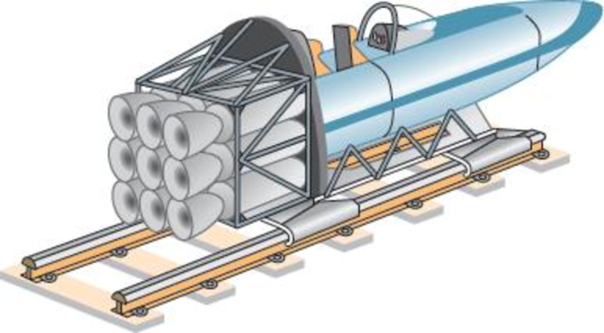
Concept explainers
A rocket sled burns fuel at the constant rate of 120 lb/s. The initial weight of the sled is 1800 lb, including 360 lb of fuel. Assume that the track is lubricated and the sled is aerodynamically designed so that air resistance and friction are negligible. (a) Derive a formula for the acceleration a of the sled as a function of time t and the exhaust velocity vex of the burned fuel relative to the sled. Plot the ratio a/vex versus time t for the range 0 < t < 4 s, and check the slope of the graph at t = 0 and t = 4 s using the formula for a. (b) Determine the ratio of the velocity vb of the sled at burnout to the exhaust velocity vex.
Fig. P14.93

Want to see the full answer?
Check out a sample textbook solution
Chapter 14 Solutions
VECTOR MECH...,STAT.+DYN.(LL)-W/ACCESS
Additional Engineering Textbook Solutions
Fluid Mechanics: Fundamentals and Applications
Mechanics of Materials (10th Edition)
Automotive Technology: Principles, Diagnosis, And Service (6th Edition) (halderman Automotive Series)
SURVEY OF OPERATING SYSTEMS
Database Concepts (8th Edition)
Electric Circuits. (11th Edition)
- Calculate the kinetic energy of a body of mass m moving with velocity u or the rate of transport of kinetic energy by a stream moving with mass flow rate m_ and velocity u. Calculate the gravitational potential energy of a body of mass m at elevation z or the rate of transport of gravitational potential energy by a stream moving with mass flow rate m_ at elevation z, where zis height above a reference plane at which potential energy is defined to equal zero.arrow_forwardA jet strikes a stationery curved vane without shock and is deflected 150° from its original direction. The discharge from the jet is 0.68kg/s and the velocity is 24m/s. Assume that there is no reduction of relative velocity due to friction and determine the magnitude and direction of the resultant force on the vane. If the vane is allowed to move with velocity of 8m/s in the direction of the jet, calculate the power developedarrow_forwardA football is thrown upward at 30.0° above the horizontal. The ball travels a horizontal distance of 40.0 m. Find: (b) the maximum altitude attained, and(c) the velocity of the ball at t = 2.00 s.arrow_forward
- A rocket is launched on a constant thrust mission in a vertical trajectory; g = 9.8 m/s 2 and dragis small compared to gravitational forces. The takeoff weight is 350 kN, the specific impulseis 300 sec. The maximum acceleration that the payload can experience is 7 g’s.Calculate the maximum velocity increment (Du) in m/s that this rocket can provide to thepayload, and if it gives this velocity to the payload, determine the mass of the payload and themass of the propellant. (Neglect the weight of the rocket casing, structure, engines, etc., sototal mass = mass of payload + mass of propellant)arrow_forwardmachearrow_forwardHI, please see attached imagearrow_forward
- a rocket of mass 1000 kg is ready for a vertical takeoff the exhaust velocity of its fuel is 4.5 km per second produced using newtonian mechanics 1. the number the minimum rate of fuel injection so that the weight of rocket be just balance 2.the velocity acquired in 8 seconds if the fuel injection latest 2.50 kg per secondarrow_forwardA ball is thrown vertically up with a velocity of 50 m /s at the edge of a 100-m cliff. Calculate the height h to which the ball rises and the total time t after release for the ball to reach the bottom of the cliff. Neglect air resistance and take the downward acceleration to be 9.81 m /s^2 .arrow_forwardthe vertical ground reaction force from a force plate during the contact phase for a 55 kg runner. If the initial vertical velocity of the runner when she first makes contact with the plate is directed 0.40 m/s downwards, determine the following:a) the vertical velocity (including direction andmagnitude) just as the runner comes off the plate at the end of ground contact. (Average net force includes the effect of gravity and thevertical ground reaction force acting on therunner) b) the average vertical ground reaction forceduring the ground contact phase of the runarrow_forward
- A projectile is launched with an initial velocity of 34.0 m/s at an angle of 35.0° elevation. What are the components of the velocity of the projectile after 3.00 s?arrow_forwardin a slapshot, a hockey player accelerates the puck from a velocity of 8.70 m/s to 35.50 m/s in the same direction. If this shot takes 3.90x10^-3 s, calculate the distance over which the pug acceleratesarrow_forwardshow all the work with diagrams pleasearrow_forward
 Elements Of ElectromagneticsMechanical EngineeringISBN:9780190698614Author:Sadiku, Matthew N. O.Publisher:Oxford University Press
Elements Of ElectromagneticsMechanical EngineeringISBN:9780190698614Author:Sadiku, Matthew N. O.Publisher:Oxford University Press Mechanics of Materials (10th Edition)Mechanical EngineeringISBN:9780134319650Author:Russell C. HibbelerPublisher:PEARSON
Mechanics of Materials (10th Edition)Mechanical EngineeringISBN:9780134319650Author:Russell C. HibbelerPublisher:PEARSON Thermodynamics: An Engineering ApproachMechanical EngineeringISBN:9781259822674Author:Yunus A. Cengel Dr., Michael A. BolesPublisher:McGraw-Hill Education
Thermodynamics: An Engineering ApproachMechanical EngineeringISBN:9781259822674Author:Yunus A. Cengel Dr., Michael A. BolesPublisher:McGraw-Hill Education Control Systems EngineeringMechanical EngineeringISBN:9781118170519Author:Norman S. NisePublisher:WILEY
Control Systems EngineeringMechanical EngineeringISBN:9781118170519Author:Norman S. NisePublisher:WILEY Mechanics of Materials (MindTap Course List)Mechanical EngineeringISBN:9781337093347Author:Barry J. Goodno, James M. GerePublisher:Cengage Learning
Mechanics of Materials (MindTap Course List)Mechanical EngineeringISBN:9781337093347Author:Barry J. Goodno, James M. GerePublisher:Cengage Learning Engineering Mechanics: StaticsMechanical EngineeringISBN:9781118807330Author:James L. Meriam, L. G. Kraige, J. N. BoltonPublisher:WILEY
Engineering Mechanics: StaticsMechanical EngineeringISBN:9781118807330Author:James L. Meriam, L. G. Kraige, J. N. BoltonPublisher:WILEY





